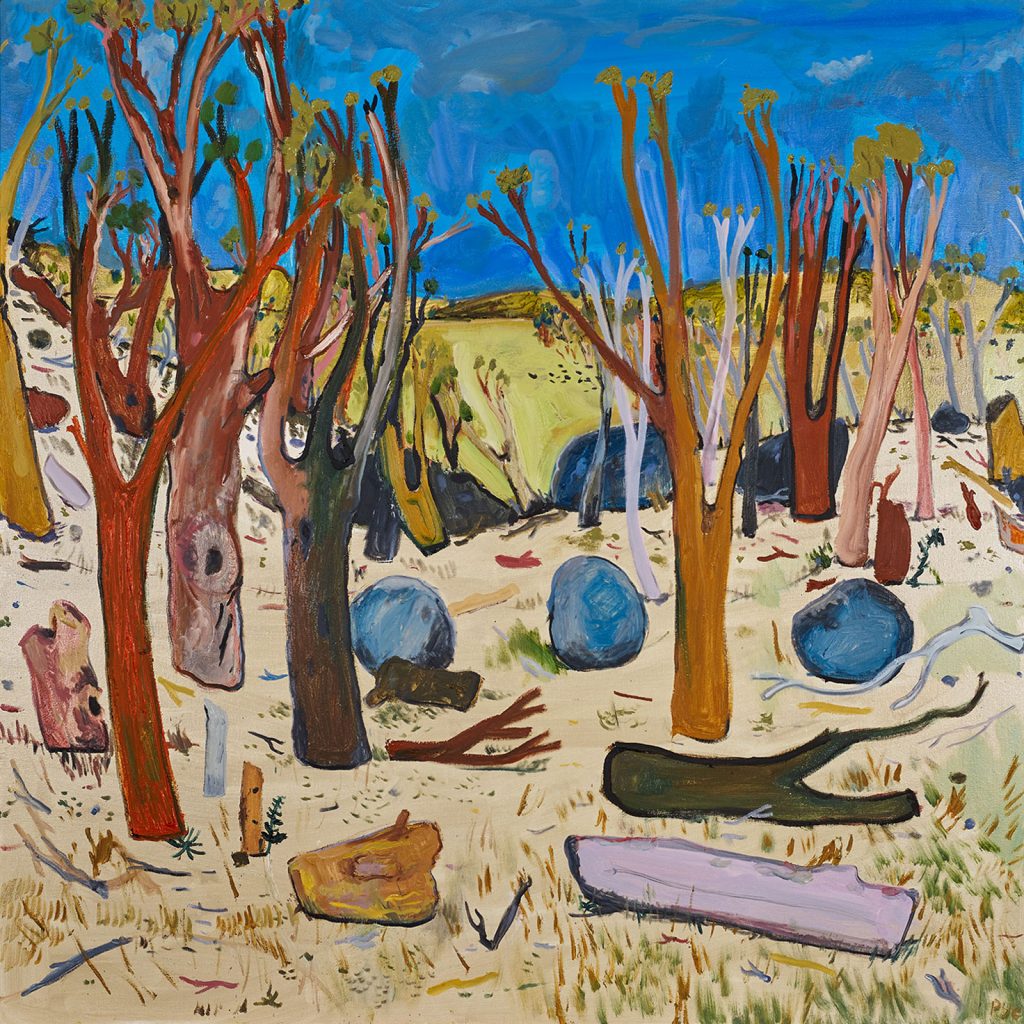There’s something I just love about Andy Pye’s work. He paints with a style that is sometimes unusual, and often highly accomplished – delivering beautiful and striking work in one moment, and work that challenges in another. I, like many others, am drawn to his Australian landscapes showcasing imperial-like powerful colours combined with wild composition – unrestricted and gutsy.
Encompassing all the chaos, drama and loneliness that the Australian bush can present, I feel like I can walk into some paintings; and that I’ve always known them. But in other cases I’m totally lost – the feeling is subdued, even bordering on conservative. Am I meant to be here? Am I meant to even admire this art?
But that’s how how it goes in the creative field. It’s virtually impossible to craft perfected magic on demand, and win every time – however much one might strive for greatness. And how the hell can you please everyone all of the time? Regardless, I love Andy’s ability to press ahead and so very often derive great wins.
Australian landscape art from the mid-twentieth-century onwards has evolved into a stand-alone movement – a powerhouse of true Australian individuality that needs to be recognised and celebrated right now. This, too, includes many great modernist Aboriginal ‘top end’ painters – Maureen Murrarngulu Thompson and Ginger Riley to name a couple. My mind also instantly jumps to Arthur Streeton’s Golden Summer and to Arthur Boyd’s various works, including a painting my father (artist) Ivan Durrant purchased to hang on his wall – a reclining nude, set among the rugged green and golds of the Aussie bush, which I adore. (This one sticks in my mind as I know all too well just how beautiful a naked bird in the bush can be.)
Unlike Boyd, Andy rarely paints people – other than one recent (and brilliant) self portrait; he concentrates almost exclusively on the Australian bush and manages to discover mesmerising scenes and objects of both natural composition and those that display man’s interference within the landscape – it’s keen observation at its best.
One example, the painting Brick Mine Study II, 2018, is one of my favourites. It has all the colour, composition and energy of a Fred Williams Pilbara scene, however for me, it takes this to a new and very daring level – displaying a large cutaway mountainside, scraped, pillaged and destroyed, yet also elevated with all the colour brilliance to light up a dull mind. It has an edginess too – like a fresh bleeding open wound; the cut is very apparent. For Andy, I feel it’s a heartfelt statement piece – this is his (micro) Sistine Chapel ceiling, and it also manages to hold the same beauty and peace.
This painting is at the heart of who I feel Andy really is as a person. A humble, but quietly-assured bloke, with a voice that’s dying to speak to the world in an articulate, clever and loving manner. He does this currently ever so cautiously which I must admit sometimes confuses me; but within his soul I also understand the great reason for his slower ‘stepping stone’ approach – Andy is no doubt taking his time in finding new ways to express himself through his art. This might very well be a wise move.
If you think I’m talking in riddles then perhaps I should cut to the chase. I’m simply suggesting that I admire the energy in Andy’s brush strokes and choice in colour and feel so much, that I know he can do no wrong – therefore I’m wanting him to strive further much faster – but am I asking for too much? Somehow I feel I can predict the future and the result is a hero of Australian art right in front of me.
Andy’s kaleidoscopic-coloured tree paintings make up an ongoing theme that are unquestionably strong. A string of exhibitions at Geelong’s Boom Gallery have netted many sales, including a list of notable private collectors snapping up large works. His painting Lookout Near Jingellic, 2017 (shown top of page), is one of the most powerful in the series: depicting a sandy foreground gully that’s sparse, dry and softly undulating.
This landscape steps back in layers to reveal greener distant hillsides and a polarised deep, deep blue sky above. The gemstone-like reflected blue-hued colours are highlighted in foreground boulders – quirky and cool – and other lighter cyan touches flowing across the canvas to create dried twigs, seem to appear as driftwood on a beach-like sandfly loam soil. Scratches of grass, wildflower stems and other branches are strewn across the scene. It is a totally honest and ‘messy’ display of the Australian landscape that’s exciting to absorb with its uninhibited sense of power and pleasure. Not an inch of historic European landscape glamour makes its way into this painting; and its alarmingly beautiful colour palette of green, golds and aquamarines amplify the hidden colours of the Aussie bush; similar in approach to the way Australian master painter Fred Williams explored colour in landscape.
For me, I ache to see Andy step ahead more quickly and speak just a little louder, a little faster. But in oh-so-many cases his work seems to fall upon perfection – what a gift. I’ve now told myself to let go and appreciate who he his and what he can achieve. As a new Australian artist on the scene, he certainly makes me feel, think and dream – and isn’t that the beauty of art right there? If it ain’t got that, it’s got nothin’.
Boom Gallery
You Yangs, Group Exhibition (includes Andy Pye), Until 28th April, 2019
11 Rutland Street, Newtown, Victoria
boomgallery.com.au
Michael Reid Murrurundi
Andy Pye Studio Direct Exhibition, April 2019
Curated by Amber Creswell Bell
michaelreidmurrurundi.com.au



Comments are closed.